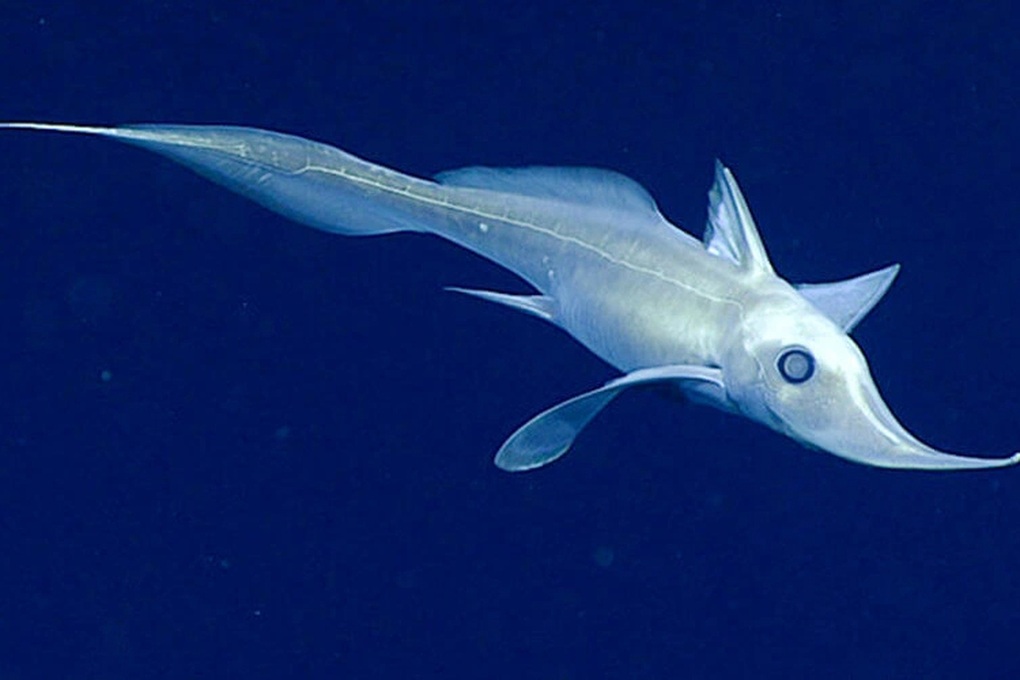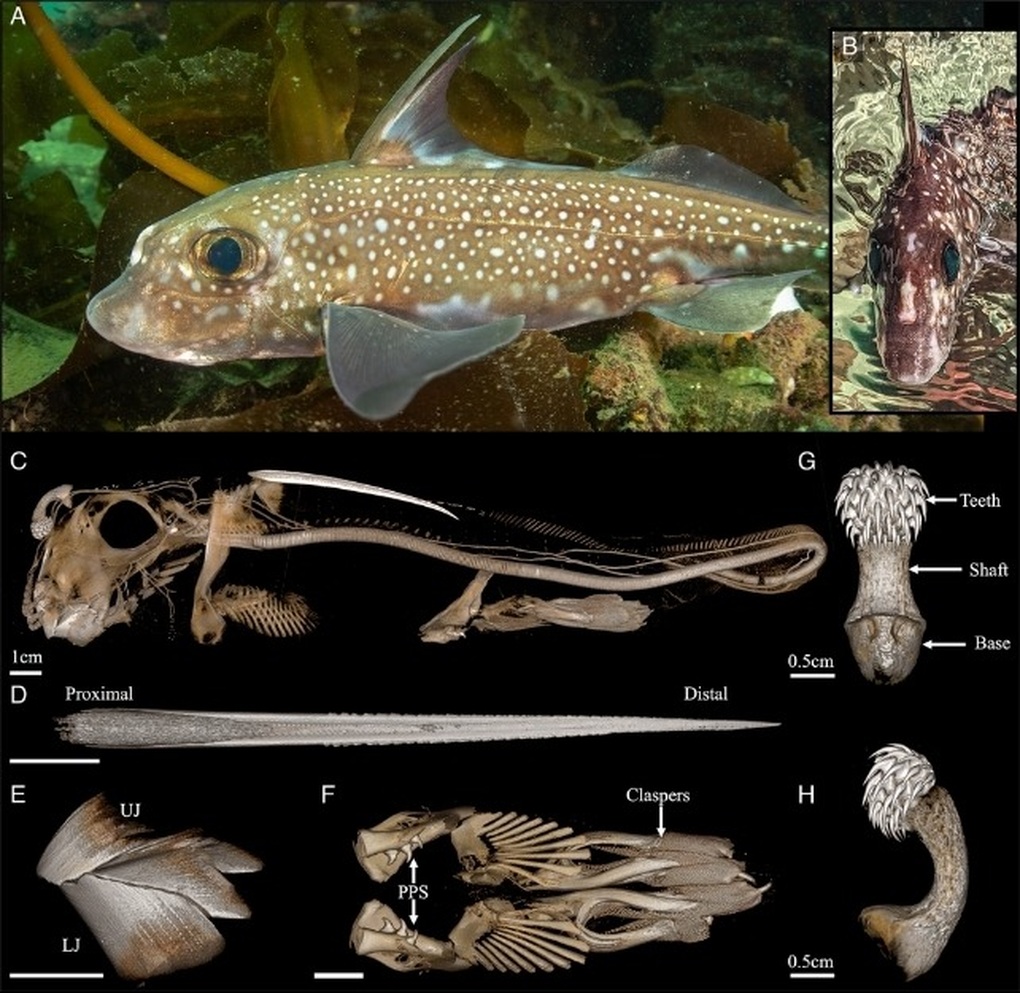In the deep ocean, where light cannot reach, exists an incredibly strange creature: the chimaera shark, also known as the ghost shark.
Not only does this fish have a haunting appearance with glowing eyes, a long, whip-like tail, and strong jaws, it also shocks scientists with a unique structure: teeth growing on its... forehead.

Ghost shark (Photo: Getty).
While most fish use their teeth for eating, male chimaera sharks use their frontal teeth for a completely different purpose: reproduction. Behind this anomaly lies an evolutionary story spanning hundreds of millions of years that modern science is only just beginning to unravel.
Strange evolutionary structure
According to Science magazine, chimaera sharks are deep-sea cartilaginous fish, distantly related to sharks and rays.
They diverged from their common ancestor about 400 million years ago and have evolved in separate directions. Unlike regular sharks, which have sharp, continuously replaced teeth, chimaeras have large, permanent, plate-shaped teeth that are specialized for crushing shellfish like snails, crabs, and crustaceans.

Tooth structure on the forehead of a ghost shark (Photo: Science).
However, what really surprised scientists was a small, fleshy stalk growing on the male's forehead that could retract, looking like a fishing rod. On it were many rows of curved, hook-like spines, never seen in any other vertebrate.
This structure is called a tenaculum, and has long puzzled scientists: is it a dermal spine, a reproductive spine, or a true tooth?
A team of researchers including Karly Cohen, Gareth Fraser and Michael Coates conducted a comprehensive analysis of the spotted ratfish – a common chimaera – using CT imaging, histological analysis and genetic data.
The results showed that the spines on the tenaculum not only resemble real teeth in shape, but also originate from dental tissue, a type of tissue that exists only in the oral region.
Even fossils of ancient chimaeras dating back more than 300 million years show that the tenaculum was once located near the upper jaw, before "moving" to the forehead over millions of years of evolution.
This means that today's frontal spines are essentially improved versions of teeth, with their function changed from feeding to reproduction.
From eating tools to reproductive weapons
So, why do ghost sharks need teeth on their foreheads? The answer lies in their unique habitat. The deep sea has no light, cold temperatures, and strong currents. In such conditions, it is difficult for males to find a mate, and even more difficult to maintain a stable mating position.
This is where the tenaculum comes in. The male uses this toothed stalk to firmly attach itself to the female’s pectoral fins or body, keeping her in place during mating.
According to Professor Coates, this is one of the typical examples showing that evolution can "recycle" an existing biological structure, reusing it for a completely new purpose.
From a set of teeth used for eating, chimaera sharks have "transformed" it into a reproductive tool - an effective survival strategy in harsh environments.
The study also challenges the traditional view of teeth. Scientists have long believed that teeth are specialized structures in the mouth, serving as digestive organs. But the chimaeras show that teeth can evolve in other positions, from the outside in or from the inside out, depending on the needs of each species.
Despite having existed for hundreds of millions of years, chimaera sharks remain a mystery. They often live at depths too deep for humans to reach, only appearing briefly when captured by submarines or research cameras.
With their glow-in-the-dark eyes and ghostly, smooth bodies, chimaeras are not only a biological mystery but also a symbol of the magic of nature.
The discovery of the teeth on the forehead of this fish species not only reveals a unique feature, but also opens up new research directions on the flexibility and creativity of evolution.
Source: https://dantri.com.vn/khoa-hoc/bi-an-chiec-rang-tren-tran-ca-map-ma-va-chien-luoc-giao-phoi-khac-thuong-20250923084030039.htm



![[Photo] General Secretary To Lam meets voters in Hanoi city](https://vphoto.vietnam.vn/thumb/1200x675/vietnam/resource/IMAGE/2025/9/23/d3d496df306d42528b1efa01c19b9c1f)
![[Photo] Editor-in-Chief of Nhan Dan Newspaper Le Quoc Minh received the working delegation of Pasaxon Newspaper](https://vphoto.vietnam.vn/thumb/1200x675/vietnam/resource/IMAGE/2025/9/23/da79369d8d2849318c3fe8e792f4ce16)

![[Photo] Prime Minister Pham Minh Chinh chairs the 14th meeting of the Steering Committee on IUU](https://vphoto.vietnam.vn/thumb/1200x675/vietnam/resource/IMAGE/2025/9/23/a5244e94b6dd49b3b52bbb92201c6986)
![[Photo] The 1st Congress of Party Delegates of Central Party Agencies, term 2025-2030, held a preparatory session.](https://vphoto.vietnam.vn/thumb/1200x675/vietnam/resource/IMAGE/2025/9/23/e3a8d2fea79943178d836016d81b4981)


















































































Comment (0)